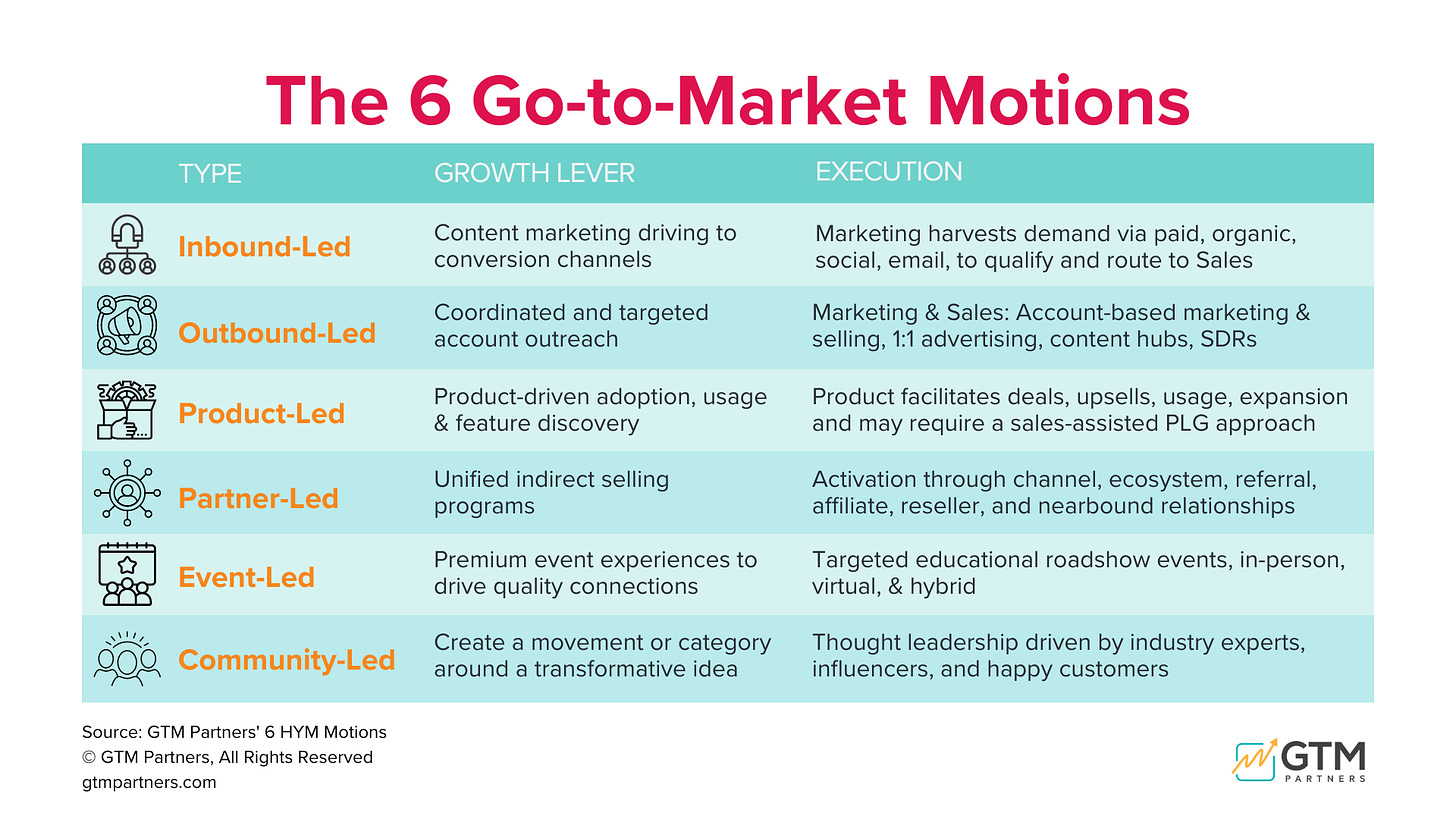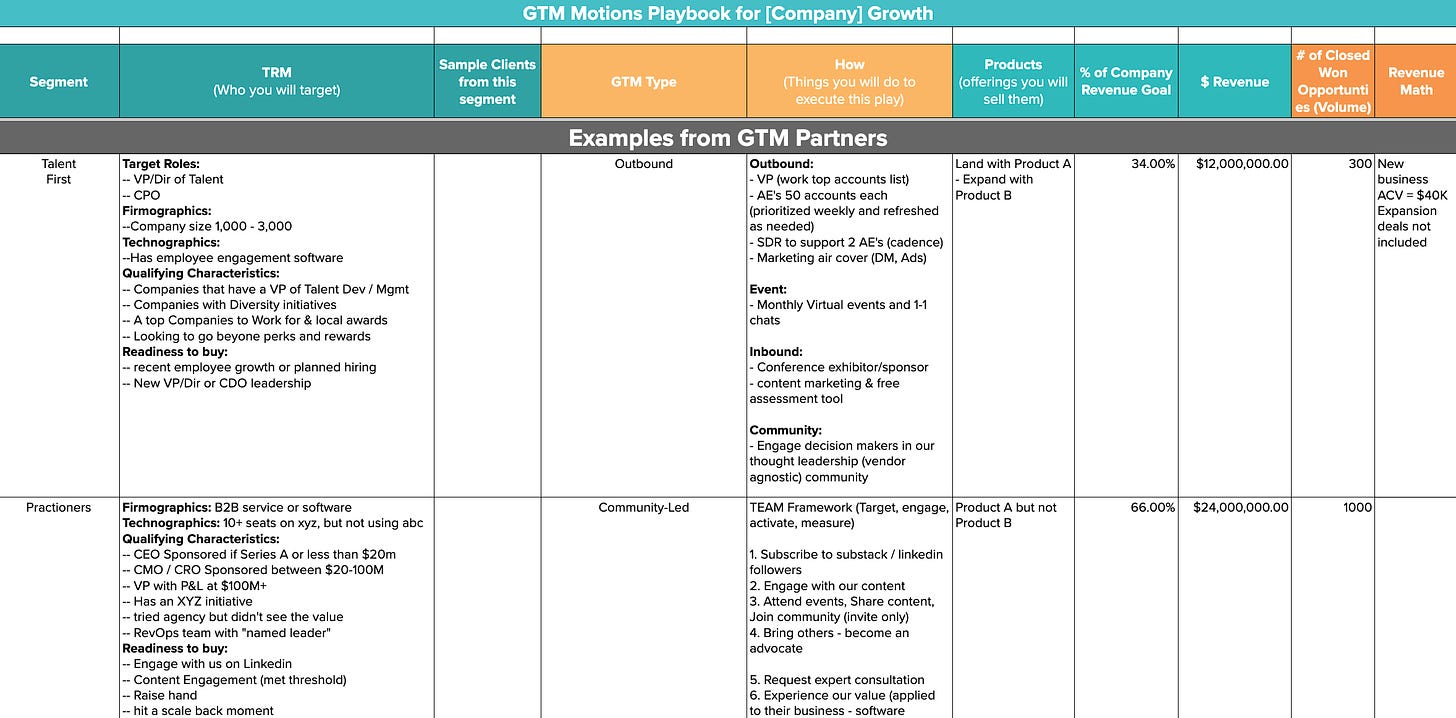Filters
The rise of Partner-Led Growth: 66% of companies leverage indirect selling programs
Raise your hand if you’re doing Partner-Led Growth!
According to our research, 66% of companies are!
It makes good sense. By collaborating with complementary businesses and channel partners, B2B companies can expand their reach, access untapped markets, and leverage their partners' expertise to create a mutually beneficial ecosystem.
This partner-led approach fosters innovation, accelerates customer acquisition, and enhances customer satisfaction, ultimately leading to substantial revenue gains for all parties involved.
We love a win-win!
Learn more about Partner-Led Growth as well as Inbound, Outbound, Product-Led Growth, Community-Led Growth, and Event-Led Growth at our Leadership Summit on August 24 about the role of brand and demand in a GTM Playbook. More details further on in the newsletter, but we wanted to give you a chance to register now!
Streamlining our 7 GTM Motions down to 6
Since launching our report on the Go-to-Market motions last spring, we’ve had conversations and trainings with dozens of companies.
We realized that Ecosystem-Led Growth and Channel-Led Growth are really subsets of a larger category: Partner-Led Growth.
We also realized that companies are already struggling with partner-related activities living across multiple silos and departments, which can undermine the value of this important GTM motion.
That’s why we’ve streamlined our GTM motions down to 6. We combined Ecosystem and Channel and renamed it Partner.
Here’s the new list.
What is Partner-Led Growth?
Partner-Led Growth is a business growth strategy where a company relies on external partners to drive sales and revenue.
Instead of solely depending on direct selling efforts, the company collaborates with partners to expand its market presence and reach new customers.
Our definition of Partner-Led Growth includes anything that comes from indirect selling programs like channels, ecosystem, referrals, affiliate programs, resellers, and nearbound relationships.
There are many similarities and overlapping conditions for each of the following subcategories of Partner-Led Growth.
Channels
Channel partners can include distributors, value-added resellers (VARs), system integrators, consultants, agencies, and other intermediaries who have established relationships with the target customers or have expertise in specific industries or markets.
By working with channel partners, the B2B company can tap into their partner's existing customer base, market knowledge, and specialized skills, enabling it to access new markets and customers more effectively.
Ecosystem
An ecosystem is a network of interconnected companies, organizations, and individuals that collaborate and depend on each other to create value and to support mutual growth. Some of the strongest ecosystems are built on overlapping or adjacent use cases, workflows, and shared data that enables customers to do what was previously not possible with only one solution.
In an ecosystem-led growth model, a B2B company focuses on building strong relationships and strategic partnerships with other companies that complement its offerings. This can include companies that provide complementary products or services, technology or data providers, consultants, distributors, or any other organization that can help enhance the overall value proposition for customers.
Referral Programs
Referral programs are initiatives where existing customers or other close partners recommend a company's products or services to someone they know. Usually they make the referral in a way that directly endorses the product or service as a solution to a problem a company is actively trying to solve. It is common for a successful referral to result in incentives or rewards.
Affiliate Programs
Affiliate marketing is a performance-based marketing strategy where affiliates (individuals or other businesses) broadly promote a company's products or services and earn a commission for each sale or lead generated through their efforts. Affiliate marketing is most common in driving freemium products, lower-priced products, or more transactional purchases of any size that don’t require a buying committee or a consultative sale.
Resellers
Resellers are third-party companies or individuals who purchase products or technology from a company and then resell them to end customers, usually adding their margin to the product price. There can be a wide variety of how these transactions occur (for example, on the reseller’s paper, provider’s paper, white labeled, bundled with limits, and specific rules around when it goes from reseller to a direct seller).
Nearbound
Nearbound refers to the concept of working deals together through an existing network of relationships. It’s a fundamentally different way of surfacing and finding opportunities and nurturing them through to sale. It assumes that the best prospects already live in your ecosystem because they are the customers or prospects of your partners.
Nearbound is a new philosophy, very similar to the way account-based marketing redefined how sales & marketing work together. Nearbound redefines how individuals from different companies work together to close more business. In this way, Nearbound can be an approach or layer that exists on top of any of the other indirect selling approaches.
Learn about the 6 GTM Motions in our virtual Leadership Summit
The GTM Partners Leadership Summit: The Role of Brand and Demand in a GTM Playbook will provide marketers with research, case studies, and market-tested strategies to enhance branding and generate demand.
It’s on August 24 - all afternoon. Please sign up even if you can’t attend the whole thing, because then you will be on the list to receive all the slides and recordings.
We have an incredible schedule of brilliant speakers, including:
Mark Lethbridge, CEO of Gravity Global will talk with our co-founder and CEO Sangram Vajre in our opening keynote about the tension between brand and demand and how to know if you have a deficit in one or the other.
Christopher Lochhead, the godfather of Category Design, will talk about how to tell when category design is a business imperative and when it’s a distraction.
Join Hushly, Pathfactory, and Uberflip for a moderated panel discussion on how content experience platforms can support all the GTM motions through the customer lifecycle.
Learn from exceptional marketers from multiple industries who are having success running different GTM motions. We’ve gotten some experienced geniuses to show you how they use a GTM motion, what their tech stack looks like, and more.
Event-Led Growth: Kate Hammitt of Splash
Outbound: Mason Cosby of Sales Assembly
Inbound: Jon Dick, SVP of Marketing at Hubspot
Community: Kathleen Booth, CMO at Pavilion
Partner-Led Growth: Tyler Calder, CMO at Partnerstack
Product-Led Growth: Darryl Praill of Agorapulse
Our brilliant analysts will lead educational opportunities that include:
Lindsay Cordell will teach about how to create a company Point of View (POV)
Bryan Brown will lead a session on which plays are needed to create vs. harvest demand
Lindsay Cordell will teach our ROI model and show how you can incorporate ROI language into your value propositions
And everyone who registers is going to get access to an exclusive GTM Motions Playbook that helps you determine where to invest in different motions, taking into account product lines, clients, ICP, and % of revenue. This one is a game-changer, and so far only our customers have gotten to use it!
The Fame, Admiration, and Belief framework
Joining us for our introductory keynote at the leadership summit on how Brand and Demand will be is Mark Lethbridge of Gravity Global. What he’s going to share is core to the very theme of our entire event.
It is proven that a balanced approach of both brand and demand is key to sustainable revenue growth over time. Unfortunately, most companies run a deficit in either one area or another (or both). The even bigger issue is that they’re unclear around how to really identify where that deficit is and even more-so, how to solve for it.
This was the challenge Gravity Global was out to solve and produced the Fame, Admiration and Belief (F.A.B) framework to do just that. Their theory is that building a powerful brand requires sustainable high levels of Fame, Admiration and Belief, compared to competitors, to drive a Disproportionate Share of Attention, which leads to relative market growth.
F.A.B. helps us to understand how a brand is performing compared to its competitors from brand to demand. It enables us to orchestrate marketing activity based on a data-led understanding of our brand position and where we need to address weaknesses or build on strengths to further competitive advantage. This in effect typically means recommending a balance of brand and demand tactics based on market intelligence and our brand position compared to our key competitors.
To learn more about the F.A.B. framework, join Mark and Sangram’s joint keynote at our August 24 event.
Hope you loved our AI summit last week (watch the replay here: nearly1500 registrations and a day jam-packed with great info).
Happy August!
Love,
GTM Partners
P.S. Some events we are having coming up. Would love to meet up with whoever will be there!
B2BSMX, Aug 7-9, Boston
Our session will be August 7, 4-5 p.m.
Sangram will be doing an incredible campfire session/workshop on the 15 GTM problems: how to know which ones you have and how to solve for them. It will be a great chance to learn practical solutions and network with peers in small groups with an assignment.
INBOUND, Sept 5-8, Boston
Session #1: The 11 Irrefutable Go-to-Market Plays That Simply Work:
Most people imagine starting and growing a business as something either daunting or nearly impossible. Unfortunately, data suggests that less than 1% of companies get to a million in revenue in their lifetime, much less in a year. Sangram had the opportunity to start two companies in the last ten years that grew from zero to million in nine months. Join this session to learn practical examples, regardless if you're a startup or a big company, on how you can jumpstart your business with these 11 plays, a GTM Operating System, and ROI model. You can steal it and apply it, today.
Session #2: Why Your Go-to-Market Is Broken and How To Fix It:
Most companies know they have challenges, but they don't know how to articulate it in order to find a way to solve it. In this deep dive, we will provide a step by step process for identifying the top 15 reasons why your Go-to-Market is broken and then outline strategies to fix it. Join this session to identify which of the top 15 Go-to-Market problems your company is facing, document a step-by-step process, metrics, and playbook to fix these challenges, and outline a clear GTM plan to grow your business and focus on outcomes.
Pavilion’s GTM2023, October 10, Nashville
Sangram will be hosting a keynote called GTM Unplugged: 5 easy-to-use frameworks that make GTM simple.
He will share our 5 most-requested and most popular frameworks that make GTM simple.
15 GTM Problems: GTM Partners’ research has identified 15 GTM problems that every company struggles with. Learn what they are, and attend Sangram’s workshop later to dig into the few that plague you the most.
The Go-to-Market Operating System: If the 15 problems are the diagnostic test, the GTM OS is the solution. Walk through the 8 pillars of the OS and how you know when to use each one.
The 6 GTM Motions: There are lots of ways to Go-to-Market (inbound, outbound, PLG, etc), and most companies use more than one way. Learn what they are, how to identify when you need a new one, and how to prioritize your efforts.
ROI: The 5 kinds of ROI and how to tell if you have an ROI problem.
Metrics: the cross-functional scorecard every GTM leader needs to identify problem areas and double down on success




